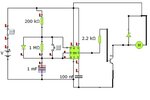ryanturner
Newbie level 4
Hi guys,
I have this circuit connected to a battery producing 12.6V, the circuit works perfectly and does what i need it to when connected to a test 10v motor. The Voltage I get across the motor is 11V.
The actual motor i am using is rated at 12V so i thought 11 would just make it run slower but does not make it run at all.
Here is the circuit, any ideas what i can do to modify it to get a higher voltage drop across it? Use an Op Amp maybe?
Thanks in advance!

I have this circuit connected to a battery producing 12.6V, the circuit works perfectly and does what i need it to when connected to a test 10v motor. The Voltage I get across the motor is 11V.
The actual motor i am using is rated at 12V so i thought 11 would just make it run slower but does not make it run at all.
Here is the circuit, any ideas what i can do to modify it to get a higher voltage drop across it? Use an Op Amp maybe?
Thanks in advance!


